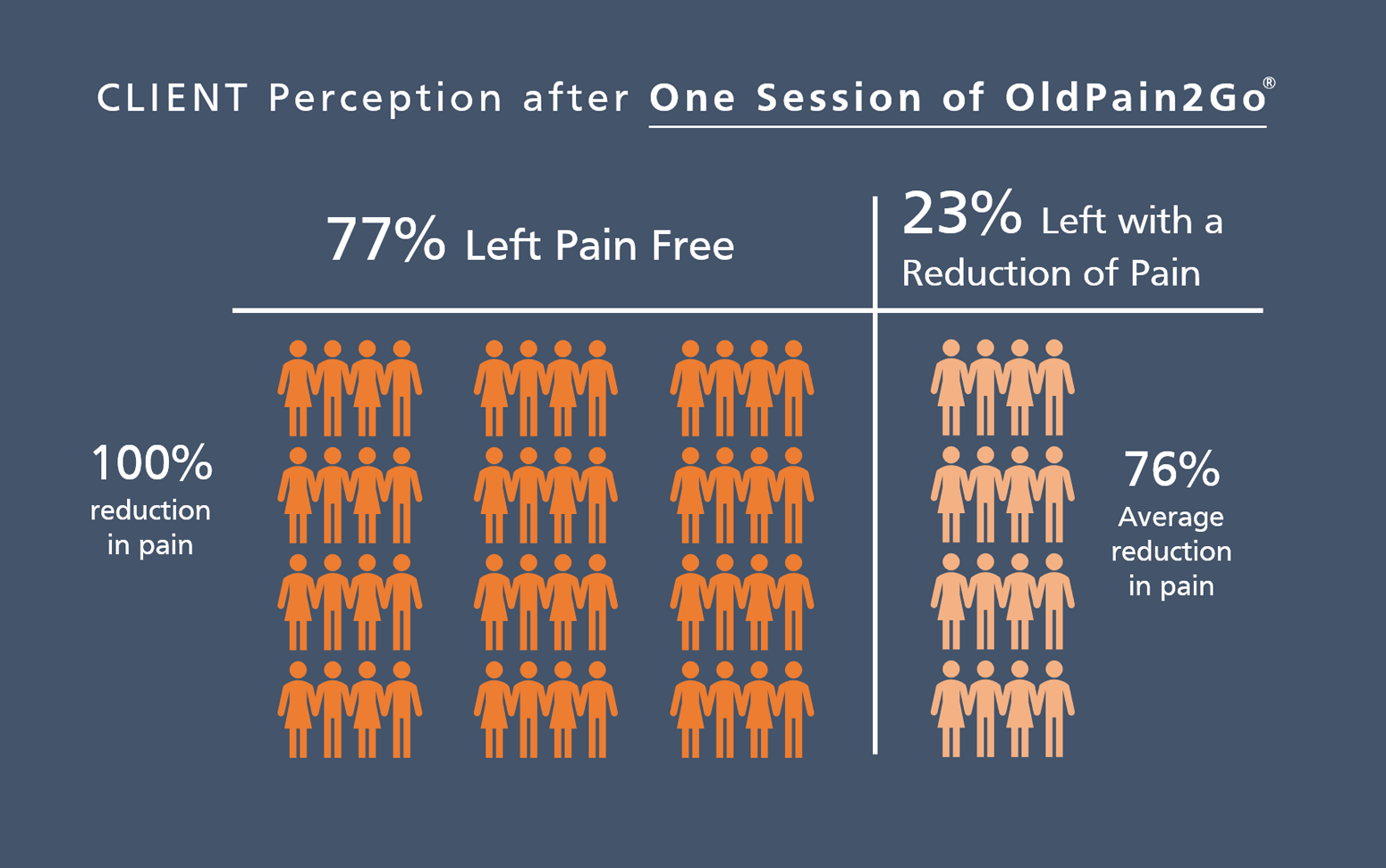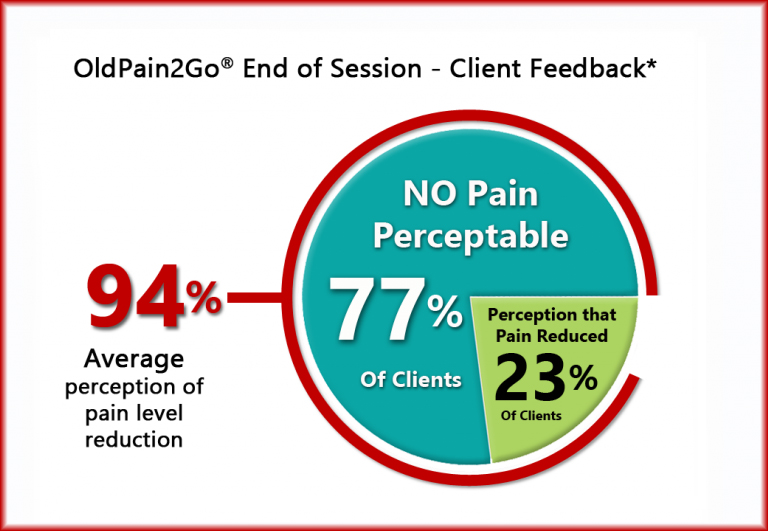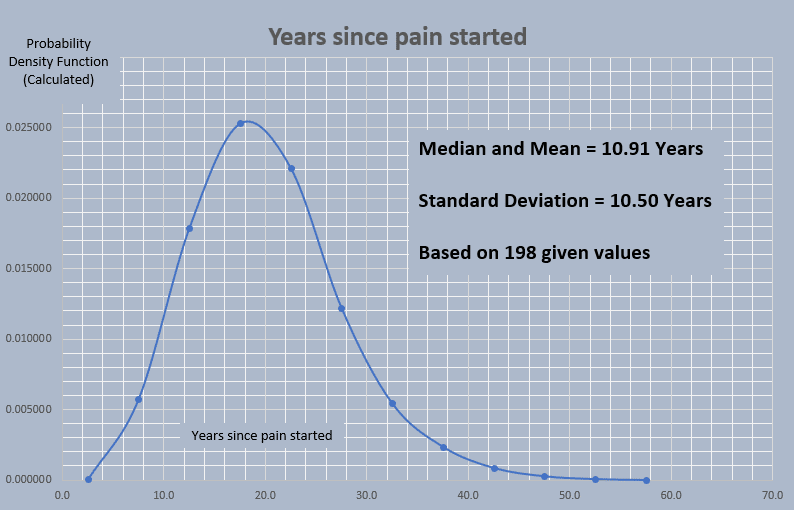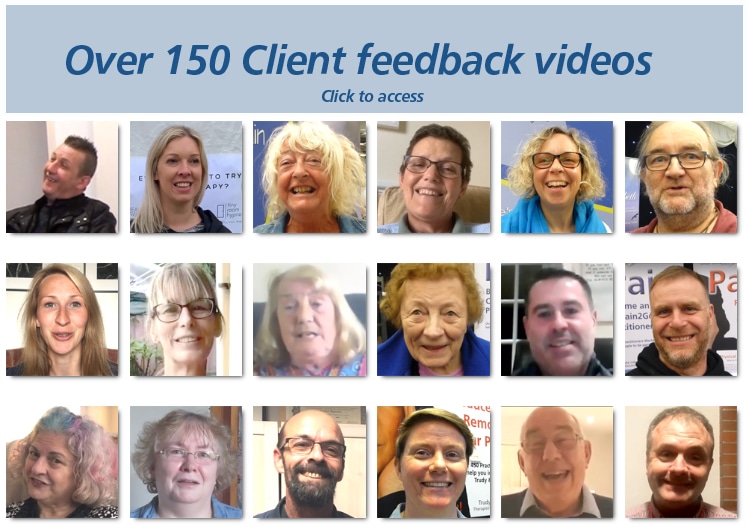
OldPain2Go® Anecdotal Result Data (216 Volunteers)
A page of assembled feedback, collected first hand, from those who had an OldPain2Go® treatment, for you to draw your own conclusions. Results are relevant only to each individual who is sharing their subjective experience.
OldPain2Go® In House Investigation
Title: Analysis of Subjective Client Feedback Data following one OldPain2Go® Treatment
Abstract:
OldPain2Go® is a non-pharmacological intervention that aims to remove chronic pain by addressing the thought processes that the brain took into account when deciding pain levels. In this study, we present an analysis of subjective feedback data collected from 216 clients who participated in training and demonstration events between November 2016 and March 2019. The feedback forms assessed the clients' own perception of pain levels before and after one session of OldPain2Go®, using the Subjective Units of Distress Scale (SUDs). The results indicate that a majority of clients perceived no pain or experienced a reduction in pain after the session, highlighting the potential efficacy of OldPain2Go® as an alternative to a pain management approach.
Introduction:
Chronic pain affects a significant portion of the global population, necessitating effective and non-pharmacological pain management approaches. OldPain2Go® is a novel intervention that targets thought processes to alleviate chronic pain. The methodology works on the effectiveness of the power of the Placebo effect and the removal of any Nocebo effect alongside the natural ability of the body to heal when the problematic thinking process is removed and any other other factors that are raised are dealt with. These are genuine and powerful effects that are real and scientifically valid, but somewhat misunderstood. Therefore blind or double-blind studies are not logical or practical for this intervention, as they are designed to remove any possibility of a placebo affect (e.g. so as not to attribute it to a drug, when testing them). Unlike with the administration of a drug it would be fairly east for anyone in the trial to quickly determine they are receiving the placebo and this could backfire on the testing. This internal analysis was conducted on subjective feedback data obtained from various events to evaluate the effectiveness of OldPain2Go® in reducing pain perception from a wide range of conditions and with different Practitioners administering the treatment.
Methodology:
The data analysed in this study were collected from 216 clients who volunteered at training and other events conducted by the creator of OldPain2Go®, Steven Blake, or by a newly trained practitioner working with their first client (close to 50/50 split). The client volunteers were assessed via telephone to ensure they met specific criteria, including a medical diagnosis, a desire to be pain-free, and a subjective assessment by Steven of their suitability for either a newly trained practitioner or himself (typically someone with Fibromyalgia). All sessions were provided totally free of charge. The clients' self-reported pain levels were evaluated using the Subjective Units of Distress Scale (SUDs) before and after one session of OldPain2Go®. This scale measures perceived pain, as pain is unique to each individual and there is no scientific method of accurately measuring pain levels.
Results:
Out of the 216 clients, 167 clients (77.31%) reported zero pain at the end of the session, while 49 clients (22.68%) perceived a reduction in pain less than 100%. Zero clients reported no change or a higher end SUDs score. The overall reduction in perceived pain across all 216 clients was 1,323 start units and 77 end units an average reduction of 94.179%.
Breakdown of Data Subset:
On further analysis, the 49 clients who still perceived some pain at the end of the session recorded a total of 327 units of pain at the beginning (average start score of 6.6 per person) and 77 units at the end (average end score of 1.57 per person). This group of people who did not get a 100% reduction of pain experienced an average reduction in pain of 76.45%.
Discussion:
The analysis of subjective feedback data from training and demonstration events suggests that OldPain2Go® may be effective in reducing perceived pain levels. The majority of clients (77.31%) reported no pain at the end of the session, a 100% reduction, while 22.68% experienced an average 76.45% reduction in pain. These findings indicate a potential benefit of OldPain2Go® as an alternative to pain management techniques for some individuals.
Limitations:
It is important to acknowledge the limitations of this study, primarily stemming from the lack of a control group and the subjective nature of the data. The absence of blind or double blind designs may introduce bias, and individual variations in response to OldPain2Go® could impact the overall outcomes. This was not a planned data collection just an analysis of data already collected to inform the practitioner of the client outcome.
Conclusion:
This analysis of subjective feedback data from events suggests that OldPain2Go® has the potential to alleviate chronic pain by addressing thought processes. The results indicate that a significant number of clients perceived no pain or experienced a reduction in pain after one session of OldPain2Go®. Further research, including controlled trials, is warranted to corroborate these findings and establish OldPain2Go® as a viable alternative for pain management.
Update: When a comparison was made between the results of the clients who were worked on by Steven Blake, the creator of the Methodology, and those worked on by someone who had completed their training in OldPain2Go® the day they worked with the volunteer, it showed on average only 6% lower outcomes than Steven's work. Whilst not a definitive statement, it does indicate that it is the methodology that works and isn't reliant on skill, experience or any authority effect.
Keywords: #chronic pain, #OldPain2Go®, #pain removal, #subjective feedback, #Subjective Units of Distress Scale (SUDs), #non-pharmacological intervention.
216 Feedbacks - Length of Time in Pain
The data collected asked the client to state how long they had been in pain up until that session. Whilst most gave usable data, some gave answers like 3 to 4 years, in which case 3.5 years was used, or stated "over 4 years" in which case 4 years was used. Some gave "since childhood" and where their date of birth was also stated 16 years was deducted from their age. Therefore all figures used are conservative. Statements such as "for ages" or "forever" were not counted, giving us 198 stated ages, which are not expected to be accurate, just the memory or perception of the person completing the form. Duration of pain ranges from recent to a person who hurt his back lifting a cement bag 59 years ago. Average duration of being in that chronic pain is 10.91 years.
The average probability for one single person coincidently recovering within that hour is: 1 in 95,592. The average probability for all 216 people coincidently recovering within that hour is: 1 in 1.514 x 10^(-45). This number is so astronomically large that it essentially signifies an impossible event based on chance alone, so results must relate to something that happened in that hour during an OldPain2Go® session.
Why does OldPain2Go® only have Anecdotal Evidence?
A "Catch 22" issue!
Scientific medical studies are accompanied by high costs, typically funded by well established pharmaceutical companies. These companies tend to invest in research projects with the anticipation of profiting from patented products. However, when it comes to talk therapies, such as OldPain2Go®, the inability to patent these approaches creates challenges in securing funding and obtaining scientific validation. Consequently, novel concepts might face dismissal from exploration by pain scientists due to it not already having established scientific evidence. This catch-22 situation poses a barrier to reaching a broader audience in need of potential solutions, hindering access to new ideas and concepts. Furthermore, without the scientific study, Health Authorities and Insurance Companies may not consider such approaches, despite their potential to significantly reduce costs and aid in a swift recovery.
Scientists often find themselves entrenched in a particular mindset, anticipating that solutions to intricate problems must be intricate themselves. Additionally, they may perceive that implementing these solutions will require lengthy time frames and intricate explanations tailored to individuals with diverse educational backgrounds. Consequently, they may not readily anticipate that practitioners outside the scientific realm can arrive at effective and enduring solutions in concise, single sessions. These sessions can yield immediately noticeable outcomes that resonate with both practitioners and clients alike. This will, of course, seem beyond credibility by the scientific community.
In contrast to scientific studies that often evaluate pain in comparison to medication, which aims to minimize placebo effects, OldPain2Go® seeks to harness the potent placebo effect intentionally. This effect, well-documented in research, holds real significance. Additionally, the methodology strives to diminish or eliminate the nocebo effect by reframing the body's perception of pain as counterproductive. It challenges the notion that enduring pain is beneficial and encourages the release of such a mindset.
Steven, as an individual cannot afford to fund a full scientific study nor is OldPain2Go® a suitable candidate for randomisation, or conducting blind or double-blind studies, where clients are unaware of the treatment or receive alternative treatments. It is not ethically, legally, or practically feasible for a therapist to trick clients, withhold treatment or not be completely honest.
Despite these limitations of study, exploring and documenting the impact of OldPain2Go® through qualitative self-reports and anecdotal evidence can still offer insights into its potential efficacy. This approach provides a means to gather valuable information without compromising ethical standards. OldPain2Go® continues to get people out of pain everyday and with 1,754 practitioners (and growing) this is a vast amount of good word going on without making people stay in pain until it catches the eye of the scientists willing and able to check it out.

As a mark of openness and for those who like to work with raw data here are the figures from the 216 Feedback Forms. Please note Ref numbers are random and the data is not in date order. See earlier notes about missing durations, and whether worked on by Steven or a newly trained Practitioner (Prac) with their first client (supervised observation).
Ref Number | Start SUD | Finish SUD | % Reduction | Years | Practitioner |
1 | 6 | 0 | 100 | 18.00 | Steven |
2 | 4.5 | 1 | 78 | 20.00 | Steven |
3 | 7 | 1 | 86 | 3.00 | Prac |
4 | 8 | 0 | 100 | 20.00 | Steven |
5 | 6 | 0 | 100 | Prac | |
6 | 4 | 0 | 100 | Steven | |
7 | 9 | 1 | 89 | 1.00 | Prac |
8 | 5 | 2 | 60 | 1.00 | Prac |
9 | 9 | 0 | 100 | 20.00 | Steven |
10 | 5 | 0 | 100 | 5.50 | Steven |
11 | 5 | 0 | 100 | 3.00 | Prac |
12 | 6 | 0 | 100 | 3.00 | Steven |
13 | 7 | 0 | 100 | 2.50 | Prac |
14 | 5 | 0 | 100 | 20.00 | Prac |
15 | 5 | 0 | 100 | 30.00 | Steven |
16 | 6 | 0 | 100 | 10.00 | Prac |
17 | 8 | 0 | 100 | 15.00 | Prac |
18 | 9 | 0 | 100 | 17.00 | Steven |
19 | 4 | 0 | 100 | 3.00 | Prac |
20 | 5 | 0 | 100 | 30.00 | Prac |
21 | 8 | 1 | 88 | 10.00 | Prac |
22 | 5 | 0 | 100 | 6.00 | Prac |
23 | 6 | 0 | 100 | 30.00 | Prac |
24 | 10 | 0 | 100 | 3.00 | Prac |
25 | 10 | 0 | 100 | 2.50 | Prac |
26 | 8 | 0 | 100 | 3.00 | Steven |
27 | 5 | 0 | 100 | 5.00 | Steven |
28 | 4 | 0 | 100 | 25.00 | Prac |
29 | 9 | 0 | 100 | 10.00 | Steven |
30 | 9 | 2 | 78 | 8.00 | Steven |
31 | 8 | 0 | 100 | 17.00 | Steven |
32 | 8 | 0 | 100 | 10.00 | Prac |
33 | 6 | 0 | 100 | 36.00 | Steven |
34 | 6 | 0 | 100 | 4.00 | Prac |
35 | 8 | 3 | 63 | 5.00 | Steven |
36 | 6 | 1 | 83 | 36.00 | Steven |
37 | 4 | 1 | 75 | 3.00 | Prac |
38 | 8 | 0 | 100 | 0.90 | Steven |
39 | 7 | 0 | 100 | 10.00 | Steven |
40 | 10 | 1 | 90 | 7.00 | Prac |
41 | 6.5 | 0 | 100 | 17.00 | Steven |
42 | 10 | 0 | 100 | 6.00 | Steven |
43 | 3 | 0 | 100 | 0.25 | Prac |
44 | 7 | 0.5 | 93 | 25.00 | Steven |
45 | 9 | 1 | 89 | 38.00 | Steven |
46 | 5 | 0 | 100 | 45.00 | Prac |
47 | 5 | 0 | 100 | Steven | |
48 | 8 | 0 | 100 | 50.00 | Prac |
49 | 6 | 1 | 83 | 3.00 | Prac |
50 | 6 | 1 | 83 | 30.00 | Steven |
51 | 6.5 | 0.5 | 92 | 2.00 | Prac |
52 | 8 | 0 | 100 | 18.00 | Steven |
53 | 4 | 0 | 100 | 15.00 | Prac |
54 | 7 | 0 | 100 | 6.00 | Prac |
55 | 3 | 0 | 100 | 0.60 | Prac |
56 | 7 | 2 | 71 | 20.00 | Steven |
57 | 10 | 0 | 100 | 19.00 | Prac |
58 | 5 | 0 | 100 | 24.00 | Steven |
59 | 3 | 0 | 100 | 55.00 | Prac |
60 | 5 | 2 | 60 | 6.00 | Prac |
61 | 7 | 0 | 100 | 18.50 | Prac |
62 | 7 | 2 | 71 | 0.50 | Prac |
63 | 7 | 2 | 71 | 0.25 | Steven |
64 | 3 | 0 | 100 | 20.00 | Steven |
65 | 8 | 0 | 100 | 20.00 | Prac |
66 | 2 | 0 | 100 | 13.00 | Steven |
67 | 3 | 0 | 100 | 0.15 | Steven |
68 | 7 | 1 | 86 | 15.00 | Steven |
69 | 6 | 0 | 100 | Steven | |
70 | 3 | 1 | 67 | 2.00 | Steven |
71 | 10 | 0 | 100 | 0.10 | Steven |
72 | 3 | 0 | 100 | 0.18 | Steven |
73 | 6 | 1 | 83 | 20.00 | Steven |
74 | 9 | 0 | 100 | 3.00 | Steven |
75 | 5 | 0 | 100 | 0.50 | Steven |
76 | 4 | 0 | 100 | 2.00 | Prac |
77 | 4 | 0 | 100 | 1.25 | Steven |
78 | 4 | 1 | 75 | 2.00 | Prac |
79 | 6 | 0 | 100 | 40.00 | Steven |
80 | 4 | 0 | 100 | 11.00 | Prac |
81 | 4.5 | 0 | 100 | 1.00 | Prac |
82 | 7 | 0 | 100 | 0.75 | Steven |
83 | 5 | 0 | 100 | 2.00 | Prac |
84 | 6 | 0 | 100 | Prac | |
85 | 4 | 0 | 100 | 5.00 | Prac |
86 | 5 | 0 | 100 | Steven | |
87 | 8 | 1 | 88 | 10.00 | Prac |
88 | 7 | 1 | 86 | 27.00 | Prac |
89 | 6 | 0 | 100 | 3.00 | Steven |
90 | 6 | 1 | 83 | 30.00 | Steven |
91 | 5 | 0 | 100 | 0.10 | Prac |
92 | 5 | 0 | 100 | 10.00 | Steven |
93 | 7 | 0 | 100 | Steven | |
94 | 7 | 0 | 100 | 10.00 | Prac |
95 | 5 | 0 | 100 | 1.50 | Steven |
96 | 10 | 0 | 100 | 2.00 | Steven |
97 | 7 | 2.5 | 64 | 3.00 | Prac |
98 | 5 | 1 | 80 | 2.50 | Prac |
99 | 7 | 0 | 100 | 2.00 | Prac |
100 | 8 | 2 | 75 | 4.00 | Prac |
101 | 4 | 0 | 100 | 20.00 | Steven |
102 | 8 | 2 | 75 | 2.00 | Prac |
103 | 8 | 3 | 63 | 4.00 | Prac |
104 | 8 | 0 | 100 | 3.00 | Steven |
105 | 7.5 | 0 | 100 | 13.00 | Steven |
106 | 7.5 | 0 | 100 | 15.00 | Steven |
107 | 6 | 0 | 100 | 40.00 | Prac |
108 | 5 | 0 | 100 | 4.00 | Prac |
109 | 9 | 0 | 100 | 10.00 | Prac |
110 | 7 | 1 | 86 | 0.50 | Prac |
111 | 9 | 1 | 89 | 0.40 | Steven |
112 | 6 | 0 | 100 | 13.00 | Prac |
113 | 8 | 1 | 88 | 30.00 | Prac |
114 | 3 | 0 | 100 | 44.00 | Steven |
115 | 3 | 0 | 100 | 30.00 | Prac |
116 | 6 | 0 | 100 | 10.00 | Prac |
117 | 10 | 0 | 100 | 3.00 | Prac |
118 | 9 | 0 | 100 | 15.00 | Prac |
119 | 5 | 1 | 80 | 0.50 | Prac |
120 | 7 | 0 | 100 | 6.00 | Prac |
121 | 4 | 0 | 100 | 4.00 | Steven |
122 | 6 | 0 | 100 | Steven | |
123 | 4 | 0 | 100 | 50.00 | Steven |
124 | 7.5 | 0.5 | 93 | 3.80 | Steven |
125 | 4 | 0 | 100 | 10.00 | Steven |
126 | 6 | 1 | 83 | Steven | |
127 | 4 | 0 | 100 | 11.00 | Steven |
128 | 6 | 0 | 100 | 5.50 | Steven |
129 | 3 | 0 | 100 | 7.00 | Steven |
130 | 8 | 0 | 100 | 0.20 | Steven |
131 | 7 | 0 | 100 | 10.00 | Steven |
132 | 6 | 0 | 100 | 2.00 | Steven |
133 | 4 | 0 | 100 | Steven | |
134 | 4 | 0 | 100 | 2.00 | Prac |
135 | 10 | 0 | 100 | Steven | |
136 | 7 | 0 | 100 | 1.50 | Prac |
137 | 4 | 0 | 100 | 13.00 | Prac |
138 | 2 | 0 | 100 | 3.00 | Prac |
139 | 7 | 0 | 100 | 1.50 | Prac |
140 | 7 | 0 | 100 | 26.00 | Prac |
141 | 6 | 0 | 100 | 0.25 | Prac |
142 | 7 | 0 | 100 | 7.00 | Prac |
143 | 7 | 0 | 100 | 34.00 | Prac |
144 | 8 | 0 | 100 | 59.00 | Steven |
145 | 3 | 0 | 100 | 30.00 | Steven |
146 | 4 | 0 | 100 | 10.00 | Prac |
147 | 3.5 | 0 | 100 | 3.00 | Prac |
148 | 6 | 0 | 100 | 4.00 | Prac |
149 | 5 | 1 | 80 | 4.00 | Prac |
150 | 5 | 0 | 100 | 4.00 | Prac |
151 | 6 | 0 | 100 | 6.00 | Steven |
152 | 6 | 0 | 100 | 20.00 | Steven |
153 | 4.5 | 0 | 100 | 11.00 | Steven |
154 | 10 | 0 | 100 | 4.00 | Prac |
155 | 7 | 5 | 29 | 4.00 | Prac |
156 | 6 | 0 | 100 | 30.00 | Prac |
157 | 7 | 0 | 100 | 5.00 | Steven |
158 | 8 | 2 | 75 | 10.00 | Steven |
159 | 8 | 0 | 100 | 6.00 | Steven |
160 | 5 | 0 | 100 | 28.00 | Steven |
161 | 8 | 0 | 100 | 4.00 | Steven |
162 | 3.5 | 0 | 100 | 0.01 | Prac |
163 | 4 | 0 | 100 | 2.00 | Steven |
164 | 8 | 0 | 100 | 20.00 | Prac |
165 | 7 | 2 | 71 | 8.00 | Prac |
166 | 7 | 0 | 100 | 10.00 | Prac |
167 | 3 | 1 | 67 | 20.00 | Prac |
168 | 4.5 | 0 | 100 | 6.00 | Prac |
169 | 2 | 0 | 100 | 0.33 | Steven |
170 | 5 | 0 | 100 | 3.50 | Steven |
171 | 6 | 0 | 100 | Steven | |
172 | 7 | 0 | 100 | 4.50 | Steven |
173 | 4 | 0 | 100 | 4.00 | Steven |
174 | 8 | 0 | 100 | 10.00 | Steven |
175 | 6 | 0 | 100 | 42.00 | Prac |
176 | 7 | 0 | 100 | 9.00 | Prac |
177 | 3 | 0 | 100 | 2.50 | Prac |
178 | 5 | 0 | 100 | 5.00 | Prac |
179 | 3 | 0 | 100 | 3.00 | Prac |
180 | 7 | 2 | 71 | 5.00 | Prac |
181 | 4 | 0 | 100 | Prac | |
182 | 3 | 0 | 100 | Prac | |
183 | 8 | 0 | 100 | 20.00 | Steven |
184 | 10 | 0 | 100 | 3.00 | Steven |
185 | 6 | 0 | 100 | 16.00 | Steven |
186 | 5 | 3 | 40 | 1.00 | Steven |
187 | 3.5 | 0 | 100 | 3.00 | Prac |
188 | 9 | 0 | 100 | 0.75 | Prac |
189 | 8 | 0 | 100 | 26.00 | Prac |
190 | 5 | 0 | 100 | Steven | |
191 | 3 | 0 | 100 | 0.40 | Prac |
192 | 5 | 0 | 100 | 3.00 | Prac |
193 | 8 | 0 | 100 | 11.00 | Steven |
194 | 8 | 0 | 100 | 6.00 | Steven |
195 | 3 | 0 | 100 | 20.00 | Steven |
196 | 8 | 2 | 75 | 8.00 | Steven |
197 | 8 | 0 | 100 | 3.00 | Prac |
198 | 9 | 5 | 44 | 3.50 | Steven |
199 | 5 | 0 | 100 | 2.00 | Steven |
200 | 6 | 0 | 100 | 3.00 | Steven |
201 | 3.5 | 0 | 100 | 0.80 | Steven |
202 | 7.5 | 0 | 100 | 23.00 | Steven |
203 | 5 | 0 | 100 | 20.00 | Prac |
204 | 6 | 3 | 50 | 0.50 | Prac |
205 | 8 | 0 | 100 | 3.00 | Prac |
206 | 4 | 0 | 100 | 5.00 | Steven |
207 | 10 | 0 | 100 | Steven | |
208 | 7 | 0 | 100 | Steven | |
209 | 6 | 1 | 83 | 11.00 | Steven |
210 | 8 | 0 | 100 | 28.00 | Steven |
211 | 8 | 0 | 100 | 15.00 | Steven |
212 | 8 | 0 | 100 | 3.00 | Steven |
213 | 5 | 1 | 80 | 5.00 | Steven |
214 | 5 | 0 | 100 | Steven | |
215 | 2 | 0 | 100 | 4.00 | Prac |
216 | 3.5 | 0 | 100 | 10.00 | Prac |



